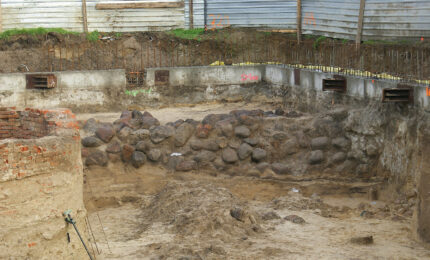Archaeologists have unearthed a large section of a 10th century defensive wall in Poznań, central Poland. Excavations in advance of construction of a new apartment building discovered the massive stone, sand and wood wall 23 feet below current ground level. At 130 feet wide and 40 feet high, it is the largest medieval defensive wall ever found in Poland.
Samples of oak wood from the wall were subjected to dendrochronological analysis and revealed the embankment was built in stages over three decades. The oldest wood came from a tree felled between 968 to 970. This is when construction of the ramparts began. The next oldest sample was felled a decade later in 980, the one after that in 986, the last in 1000.
Poznań was founded as a defensive fortress on an island between the Warta River and its tributary the Cybina. The stronghold was believed to have been built in the 8th or 9th century by the Polans, the Slavic tribe that gave the country its name, first settled in the Warta river basin in the 8th century. It is one of the oldest cities in Poland and was an important political, military and religious center at the dawn of the Polish state. Duke Mieszko I, the first Christian ruler of Poland, is believed to have been baptized in Poznań and the first Christian bishop of Poland took Poznań as his episcopal seat and the first cathedral in Poland was built there in the late 10th century.
The discovery of such a large the wall proves that the southern part of the castle complex was much larger than previously believed and that the town it defended was of major significance.
Given that only the more important settlements featured such ramparts and that Poznań’s defensive infrastructure consisted of three fortified rings joined together, suggests that the city could have been the country’s first capital, rather than the nearby city of Gniezno as previously thought.
Antoni Smoliński, the chief archaeologist working on site, said:
“Until now, we believed that Poznań was a settlement of secondary importance. However, given the discovery of the massive defences, this statement is highly questionable. The Early-Medieval city was, indeed, a strategic centre and the post-christening capital of Mieszko I’s Poland.”


A 40 foot tall wall 23 feet below the currant ground level?
I must be missing something here.
Rob, from the ‘firstnews.com’ article:
“Built out of wood, stone and sand, the defensive walls were impressive by then-standards as they were 40 meters thick and stood 12 meters tall [i.e. 40ft], the biggest of their kind in Poland.”
Indeed, they were definitely not 40m thick, but maybe a bit more than 2-3m (cf. pics). Their original 12m height is seemingly an estimation. Also, the current ground level is, of course, the original one ‘plus x’.
:hattip:
PS: OK, those “three fortified rings” might have been 40m wide altogether, …in case that they stood simultaneously 😉
BTW, my grandma was born there, and maybe I should have a look myself.
Where’s the Rosetta-stone of universal dimensions-terms?
I know I’m thick-headed, but I’d go to any length to heighten the depths of my understanding and widen my knowledge-base.
wRJqTGLtWHKnFuag
lJwahkEZd